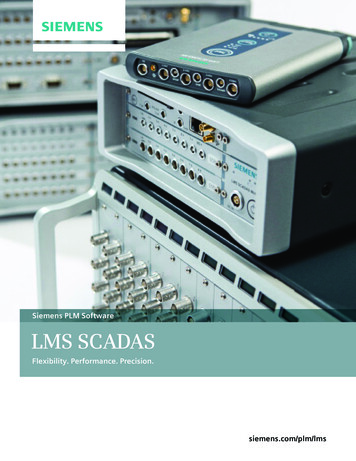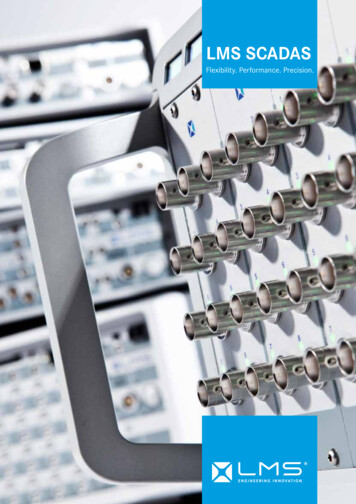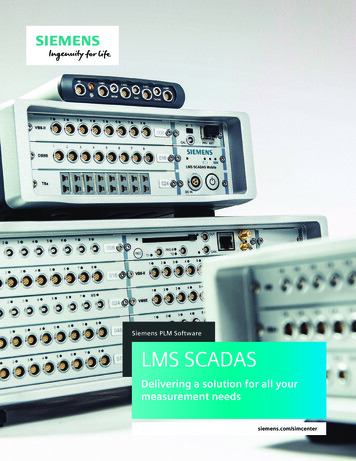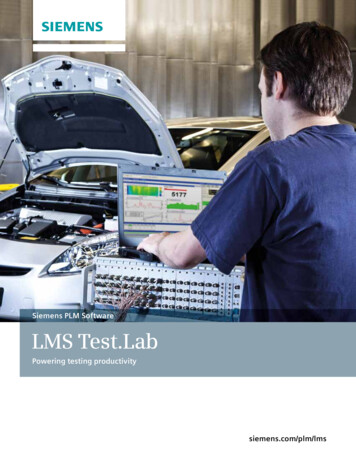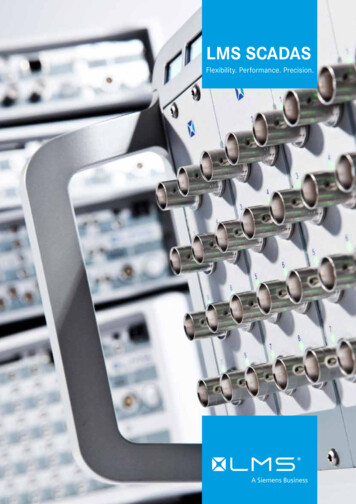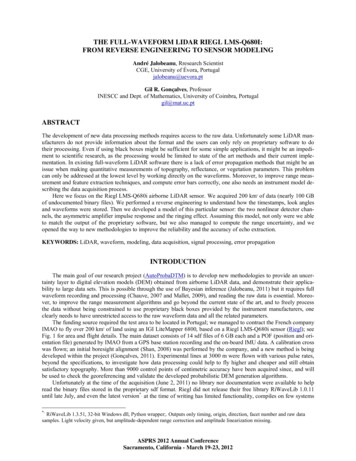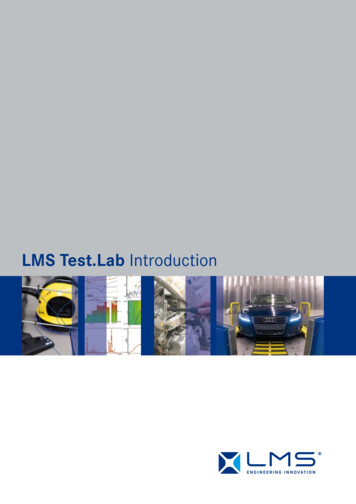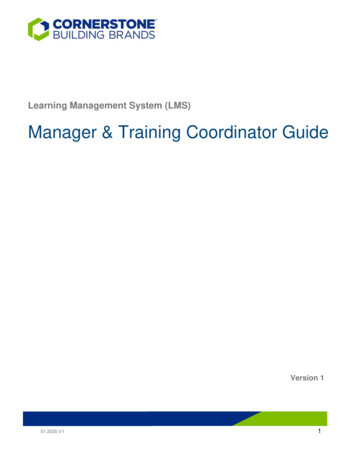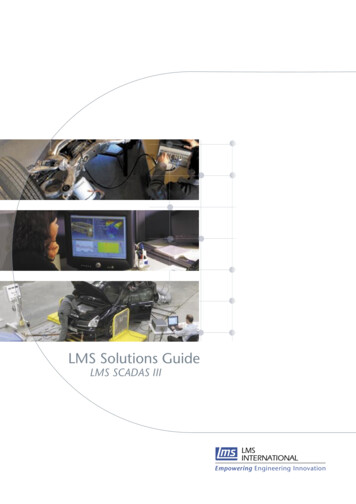
Transcription
LMS Solutions GuideLMS SCADAS III Empowering Engineering Innovation
LMS SCADAS IIILMS SCADAS IIISignal Conditioning and Data Acquisition for Lab and Field TestingLMS SCADAS III offers complete, high-quality and cost-effective solutions for high-speed data acquisitionand signal conditioning, in a wide range of applications. The SCADAS III front-end is tightly integratedwith the LMS Test.Lab software and optimally tuned to meet the specific needs of noise and vibrationengineering. It offers a flexible choice of hardware frames and modules and an outstanding performance.Maximum modularity The modular LMS SCADAS III solution can expand from an inexpensive base with only four channels,to a mobile solution for operation from a vehicle battery, to a distributed system with over a thousandchannels. SCADAS III has a very flexible architecture that lets you configure the system to your preciseneeds – add more channels, swap signal conditioning modules and boost the signal processing poweras you wish. The LMS SCADAS III front-end family offers system configurations for laboratory andmobile usage, and offers the possibility to standardize laboratory and field-testing on the same hardwareplatform. The tight integration of LMS SCADAS III with the LMS Test.Lab software offers operators thecomfort of working with the same common software platform for all their testing tasks, both in the laband in the field. and optimal scalabilityThe scalability of LMS SCADAS III enables its users to apply a high number of measurement channels inextensive testing campaigns, using a daisy-chained master/slave configuration, or divide the channels overmultiple separate testing systems. The master frame can optionally be connected to the host computer bya fiber optic link with a maximum length of 500m, and each slave frame can be over 50m away from theprevious master or slave frame. This distributed approach means that you can minimize costly transducercabling - and obtain much higher quality measurements. One single platform for laboratory and field-testing Tightly integrated with LMS Test.Lab Delivering maximum user comfort, flexibility and test data consistency Superior modularity and scalability protects hardware investments Direct plug & play connection of transducers and distributed frames reduces setup time Higher quality data, with measurement chain integrity indication Parallel signal processing capacity safeguards system performance as channel count increases2LMS International www.lmsintl.com info@lms.be
LMS SCADAS IIIHigh performance digitization and DSPThe outputs from the various signal conditioning modulesare routed to the SP92 digitizer cards in a very flexible andsoftware controlled manner. Digitization incorporates stateof the art delta-sigma techniques that combine an ultralow noise floor with fully linear 24-bit system performanceat up to 204.8kHz per channel. The combination of a highthroughput capacity host interface with 24-bit fixed pointDSPs on each four-channel module enables a maximumdistribution of processing power for true real-time operationson a large number of channels. Processing functions includedigital filtering and decimation, order tracking and harmonicextraction, as well as real-time third octave filtering.The LMS SCADAS 305 mobile testing front endincludes high quality acquisition power into acompact and rugged design.Designed for noise and vibration engineeringLMS SCADAS III supports virtually all types of transducersrelevant in the world of NVH measurements. Whetheryou want to capture rpm, acceleration, speed, force,displacement, strain, temperature, sound or torsion: SCADASIII offers an off-the-shelf solution. Dedicated high precisiontacho acquisition allows order tracking as well as spectral/octave acquisitions against rotational speed. Tacho signals upto 15kHz and 1024 pulses per revolution are supported, whileauto-ranging inputs and programmable signal conditioningensure that even ‘industry quality’ analog tacho signals withall kinds of noise and changing amplitudes will still resultinto stable readings. For Vibration Control or Time WaveReplication applications, we offer the possibility of installingfrom 2 up to 60 generator channels in one single SCADASIII frame. Output signals with ultra-low distortion and noiseare ensured by the use of 24-bit digital to analog bit streamconverters.The LMS SCADAS 310 portable front end excels inperformance and flexibility, with 10 slots for up to40 channels or more in master slave configurationfor high channel count testing.Delivering superior hardware qualityLMS SCADAS III achieves high-level reliability throughrigorous design standards, efficient quality control and astrong service organization. Our quality standards are theoutcome of a 25-year accumulation of practical knowledgein signal conditioning and processing. We are critical whenselecting components and suppliers - and quality controlbegins in the prototype phase. Our products are consideredout of development only when the first productionseries is completed successfully to ISO9001 standards.Careful tracking of each system module allows our serviceorganization to carry out preventive maintenance for ourcustomers so that downtime for calibration or repair isreduced to an absolute minimum.The LMS SCADAS 316 combines extremelyhigh channel counts possibilities, real timeprocessing capabilities and unmatched throughputperformance.3LMS International www.lmsintl.com info@lms.be
LMS SCADAS IIILMS SCADAS 305, mobile data acquisition powerThe LMS SCADAS 305 mobile front-end can be installed just as easily in the test laboratory as in a test vehicle.Accommodating from 4 up to 20 channels in a compact frame, SCADAS 305 sets a new benchmark for highperformance mobile testing. This mobile data-acquisition front-end is not just easy to carry; it also offers easy cableconnections. All cables, except the AC mains power cable, plug in the front side of the LMS SCADAS 305, facilitatinginstallations in locations that are small or difficult to access. Its wide-range power supply accepts AC and DC inputvoltages, but it can also operate from the built-in battery.This mobile front-end packs the renowned quality and acquisition power of LMS SCADAS III into a compact and ruggeddesign, offering a versatility of data-acquisition and signal-conditioning capabilities and maximum ease of transportation.The hardware architecture that it shares with other LMS SCADAS III test equipment assures that signal-conditioningmodules are easily interchangeable. The tight integration and optimal tuning between LMS SCADAS III test hardwareand LMS Test.Lab / LMS CADA-X software delivers maximum performance, user comfort, test data consistency andreliability.LMS SCADAS 305 at a glanceSmall rugged frame foruse in the fieldBattery backup: guaranteedindependent operation for morethan ten minutesEasily interchangeablesignal-conditioning modulesFlexible host interface forplug & play operationExpandable from 4 to 20measurement channelsBuilt-in calibration source for easysystem and module calibrationAll connectors on front panel,except AC mains inletOn-board dual tacho and signalgeneration (no extra slots required)LMS SCADAS 305mainframeLMS SCADAS 306Sslave frameNumber of slots56Max number of channels per frame2024Max total channel count (master/slave combined)44n.a.Dimensions (WxHxD)410 x 110 x 410 mm410 x 110 x 410 mmWeight8 kg (fully equipped)8 kg (fully equipped)AC power input88 to 264VAC88 to 264VACDC power input10 to 42VDC10 to 42VDCMax power consumption100W100WBattery operationYes (more than 10 minutes)Yes (more than 10 minutes)Host interfaceSCSIn.a.Master/Slave interfaceStandardStandardAssociated slave framesLMS SCADAS 306Sn.a.4LMS International www.lmsintl.com info@lms.be
The LMS SCADAS 310 front-end accommodates 10 slots for up to 40 channels in a portable system thatretains the full SCADAS III performance and flexibility. It can scale up to relatively static setups for testlaboratories, or be scaled down to a minimum for mobile in-vehicle measurements. With the optionalmaster slave interface, the SCADAS 310 can be combined with other SCADAS III frames in order toparticipate in a high channel count testing campaign.LMS SCADAS IIILMS SCADAS 310, the compact lab systemLMS SCADAS 310 at a glancePortable frame for laband field useExpandable from 4 to 40measurement channelsEasily interchangeablesignal-conditioning modulesBattery backup: guaranteedindependent operation formore than ten minutes(DC version only)Built-in calibration sourcefor easy system and modulecalibrationIndustry standard wide ornarrow SCSI host interfaceLMS SCADAS 310mainframeLMS SCADAS 310DCmainframeLMS SCADAS 311SDCslave frameNumber of slots101011Max number of channels per frame404044Max total channel count (master/slave combined)401840n.a.Dimensions (WxHxD)336 x 183 x 461 mm336 x 183 x 461 mm336 x 183 x 461 mmWeight13 kg (fully equipped)13 kg (fully equipped)13 kg (fully equipped)AC power input88 to 264VAC88 to 264VAC88 to 264VACDC power inputNone10 to 42VDC10 to 42VDCMax power consumption160W160W160WBattery operationNoYes (more than 10 minutes)Yes (more than 10 minutes)Host interfaceSCSISCSIn.a.Master/Slave interfaceOptionalStandardStandardn.a.LMS SCADAS 311SDCLMS SCADAS 317Sn.a.Associated slave frames5LMS International www.lmsintl.com info@lms.be
LMS SCADAS IIILMS SCADAS 316, the versatile lab systemLMS SCADAS 316 offers a unique combination of extremely high channel count possibilities, channel count independentreal time processing capabilities and unmatched throughput performance. The modular LMS SCADAS 316 frame with16 slots for up to 64 channels allows channel counts expansion as needed, with the possibility to connect multipleframes in master/slave configurations. This modular solution can fit the need of any noise and vibration laboratory,starting from an inexpensive base with only four channels - to a system with several hundreds of channels. The scalabilityand modularity of LMS SCADAS III enables its users to apply a high number of measurement channels in extensivetesting campaigns, or divide the channels over multiple testing systems. A low noise floor and fully linear 24-bit systemperformance at up to 204.8kHz per channel characterize the high-quality digitization of the signal. A high-speed DSPon each 4-channel module delivers high distributed power for real-time operations with high channel counts. Themaster frame can optionally be connected to the host computer by a fiber optic link, and each slave frame can be over50m away from the previous master or slave. This distributed approach means that you can minimize costly transducercabling and obtain much higher quality measurements.LMS SCADAS 316 at a glanceExpandable from 4 measurementchannels up to 2000Prepared for 19” rack mountingEasily interchangeablesignal-conditioning modulesMaximum throughputperformance of 6.5 MSamples/sBuilt-in calibration source for easysystem and module calibrationIndustry standard wide ornarrow SCSI host interfaceLMS SCADAS 316mainframeLMS SCADAS 317Sslave frameNumber of slots1617Max number of channels per frame6468Max total channel count (master/slave combined)1920n.a.Dimensions (WxHxD)448 x 183 x 461 mm448 x 183 x 461 mmWeight20 kg (fully equipped)20 kg (fully equipped)AC power input88 to 264VAC88 to 264VACDC power inputNoneNoneMax power consumption220W220WBattery operationNoNoHost interfaceSCSIn.a.Master/Slave interfaceStandardStandardAssociated slave framesLMS SCADAS 311SDCLMS SCADAS 317Sn.a.6LMS International www.lmsintl.com info@lms.be
The LMS SCADAS III mainframe accepts up to 11 different module types, including any combination of input/outputcards, tacho inputs and a variety of signal conditioning modules. The integrated signal conditioning and directconnection of each transducer to the inputs eliminates interconnection problems associated with multiple units orbreakout boxes, such as hum, noise, and ground loops. The entire measurement chain is continuously monitoredduring testing for open or short circuits. Overload checks are carried out on several places in the signal paths,including full bandwidth checking upfront of the anti-alias filters. Finally, calibration is on a module-by-module basisand is an entirely digital process. This ensures high quality data over an extended period, or when cards are swappedover.LMS SCADAS IIIMix and match data acquisition channelsLMS SCADAS III input modulesProgrammable Quad Amplifier (PQA)The PQA is a basic four-channel voltage/ICP conditioning module. Each channelhas an individually programmable inputrange, with AC/DC/ICP coupling, andan analog A-weighting filter. The PQA hasgrounded BNC inputs.Programmable Quad Floating Amplifier (PQFA)The PQFA adds a number of features to thebasic PQA concept. Floating inputs eliminatethe risk of ground loops, and an analogprogrammable high pass filter removesunwanted low frequency components.Smart transducers (TEDS) can be connecteddirectly to the PQFA module. It helps usersto drastically reduce the setup time and evenmore important, to avoid cabling errors,which can possibly call for a rerun of themeasurement. Input range 62.5mV to 10V Input range 100mV to 10V 4mA ICP supply Floating / single ended inputs Analog A-weight filter 4mA ICP supply 5 to 75Hz programmable high pass filter TEDS supportProgrammable Quad Microphone Amplifier (PQMA)The PQMA is ideal for vibro-acousticmeasurements. It can connect fourconventional, prepolarized or ICP microphones, as well as force transducers,or voltage inputs. The analog high-passfilter optimizes the use of the ADCsdynamic range.Programmable Quad Charge Amplifier (PQCA)The PQCA can connect four conventionalpiezoelectric accelerometers to the systemusing microdot connectors and the builtin charge amplifier. The PQCA has anexceptionally high dynamic range for themost demanding structural measurements. Input range 62.5mV to 25V Input range 25pC to 51200pC Semi differential inputs Single ended inputs 4mA ICP supply 0.5 or 5Hz high pass filter 1 to 255Hz programmable high pass filter 200V polarization voltage 30 or 60V preamplifier supply7LMS International www.lmsintl.com info@lms.be
LMS SCADAS IIILMS SCADAS III input modulesProgrammable Quad Bridge Amplifier (PQBA)The PQBA supports four channels of straintransducers - and those based on the sameprinciple, such as piezoresistive or variablecapacitor sensors. Full, half, and quarterbridge configurations are supported, withbridge completion resistors fully softwareswitched. Automatic bridge nulling usescurrent injection techniques. Input range 5mV to 1VQuad Digital Audio Module (QDA)Supporting AES/EBU and SPDIF data formats,the QDA is a dedicated audio interfacemodule, specifically designed for artificialheads. The QDA accepts 16 or 24-bits dataand all standard audio sample rates. HMSdata is retrieved from the audio stream andseparately sent to the host. Because the QDAresamples the input data to the standardSCADAS III internal sample rates, the outputdata of QDA is fully compatible with datafrom other modules. Therefore, digitalaudio measurements can be done in parallel(synchronous) with other vibration or soundmeasurements. Fully differential inputs Support of AES/EBU and SPDIFinput data at all standard sample rates Maximum 5V bridge supply with sense mechanism Support of HMS data Bridge nulling and calibration usingaccurate current injection techniques Synchronization of digital audiostreams with other inputs All processing functions, including filtering, ordertracking and 1/3rd octave are availableLMS SCADAS III tacho modulesProgrammable Dual Tacho Module (PDT)The tacho module allows order tracking aswell as spectral/octave acquisitions againstrpm. Tacho signals up to 15kHz and 1024pulses per rev are supported, while autoranging inputs and programmable signalconditioning ensure that even ‘industrialquality’ analog tacho signals with noiseand changing amplitudes will result instable readings. Auto ranging differential input Bias voltage compensation from –5V to 5V 40ns tacho counter resolution Tacho preview with 16-bit ADCQuad Torsional Vibration Module (QTV)The QTV is a four-channel tacho inputmodule, designed for the acquisition andanalysis of torsional vibration phenomena.Through the use of high bandwidth ADCsand dedicated embedded processing, theQTV is able to detect and represent highfrequency tacho variations with a precisionthat exceeds that of conventional (counterbased) solutions. QTV dynamic rpm data isacquired with 24-bit precision and is perfectlysynchronous with all other input channelspresent in the LMS SCADAS III system.The LMS SCADAS III QTV module offers adedicated solution for highly accurate torsionanalysis of rotating objects. Input range 62.5mV to 25V Maximum tacho frequency 50kHz Double and missing pulse compensation Acquisition synchronous with all otherinput channels in LMS SCADAS III rpm smoothing filter Frequency independent resolution8LMS International www.lmsintl.com info@lms.be
Quad Digital to Analog Converter (QDAC)Output signals with ultra-low distortionand noise are ensured by the use of 24-bitdigital to analog bit stream converters,analog and digital reconstruction filters,and up-sampling digital filters with noiseshaping. The four channel QDAC moduleincludes firmware to support sine, random,burst sine or random, chirp and arbitrarysignal generation. This output moduleis also available in a two channel variant(DDAC). 24-bit signal generation 20kHz bandwidth 5V output voltageQuad Monitor Output Amplifier (QMO)The QMO is a four-channel output modulefor SCADAS III. As an output amplifier,it provides an analog output of one ofthe stacked signal conditioners. Theoutput amplifier is AC coupled. The QMOmodules support recording in parallel tothe normal acquisition via the SCADAS IIIon e.g. a tape recorder in data reductionsystems.LMS SCADAS IIILMS SCADAS III output modules Calibrated monitor output 2V output voltage Short circuit protected Short circuit protectedDual channel output for VibCo and Durability (VDAC)The VDAC is a versatile dual channel output module for applications such as vibration control testingand time waveform replication, but also for Multiple Input Multiple Output (MIMO) modal testing.It can be used as an advanced signal generator or to replay signals that are generated on the hostcomputer. To assure a true replay of the original signals, ultra-low distortion digital interpolationfilters are used. Dedicated hardware circuits guarantee smooth shutdown of the output signals,even in case of power failure, to protect the structure under test. 24-bit signal generation 20kHz bandwidth 10V output voltage Fail-safe9LMS International www.lmsintl.com info@lms.be
LMS SCADAS IIIOverview LMS SCADAS III signal conditioning modulesInput ModulesPQAPQFAPQMAVoltage and ICP Floating voltageand ICP , with TEDSMicrophone andICP 444Connector4 x non isolatedBNC4 x isolated BNC4 x 7-pole LEMOInput modeSingle endedFloating and singleendedSemi differentialInput couplingDC/AC/ICP DC/AC/ICP /TEDSDC/AC/ICP 62.5mV to 10V 100mV to 10V 62.5mV to :5 to 75HzHigh-pass:1 to 255HzSignal to noise ratio 90dB 100dB 88dBTotal harmonic distortion -87dB -90dB -87dBCrosstalk -106dB -106dB -100dBInput ModulesPQCAPQBAQDAFunctionChargeFull, half andquarter bridgeDigital audio: AES/EBU and SP-DIF442 x stereoConnector4 x 10-32 Microdot4 x 6-pole LEMO2 x 3-pinLEMO and cinchInput modeSingle endedFully differentialDigitaln.a.DCn.a. 25pC to 51200pC 5mV to 1Vn.a. 0.1Ω1GΩ//50pFTTL compatibleHigh-pass:0.5 or 5HzNonen.a.Signal to noise ratio 88dB 93dB 139dBTotal harmonic distortion -87dB -87dB -123dBCrosstalk -106dB -106dBn.a.FunctionNumber of channelsFull scale input rangeInput impedanceAnalog filteringNumber of channelsInput coup
LMS International www.lmsintl.com info@lms.be LMS SCADAS 305, mobile data acquisition power The LMS SCADAS 305 mobile front-end can be installed just as easily in the test laboratory as in a test vehicle. Accommodating from 4 up to 20 channels in a compact frame, SCADAS 305



